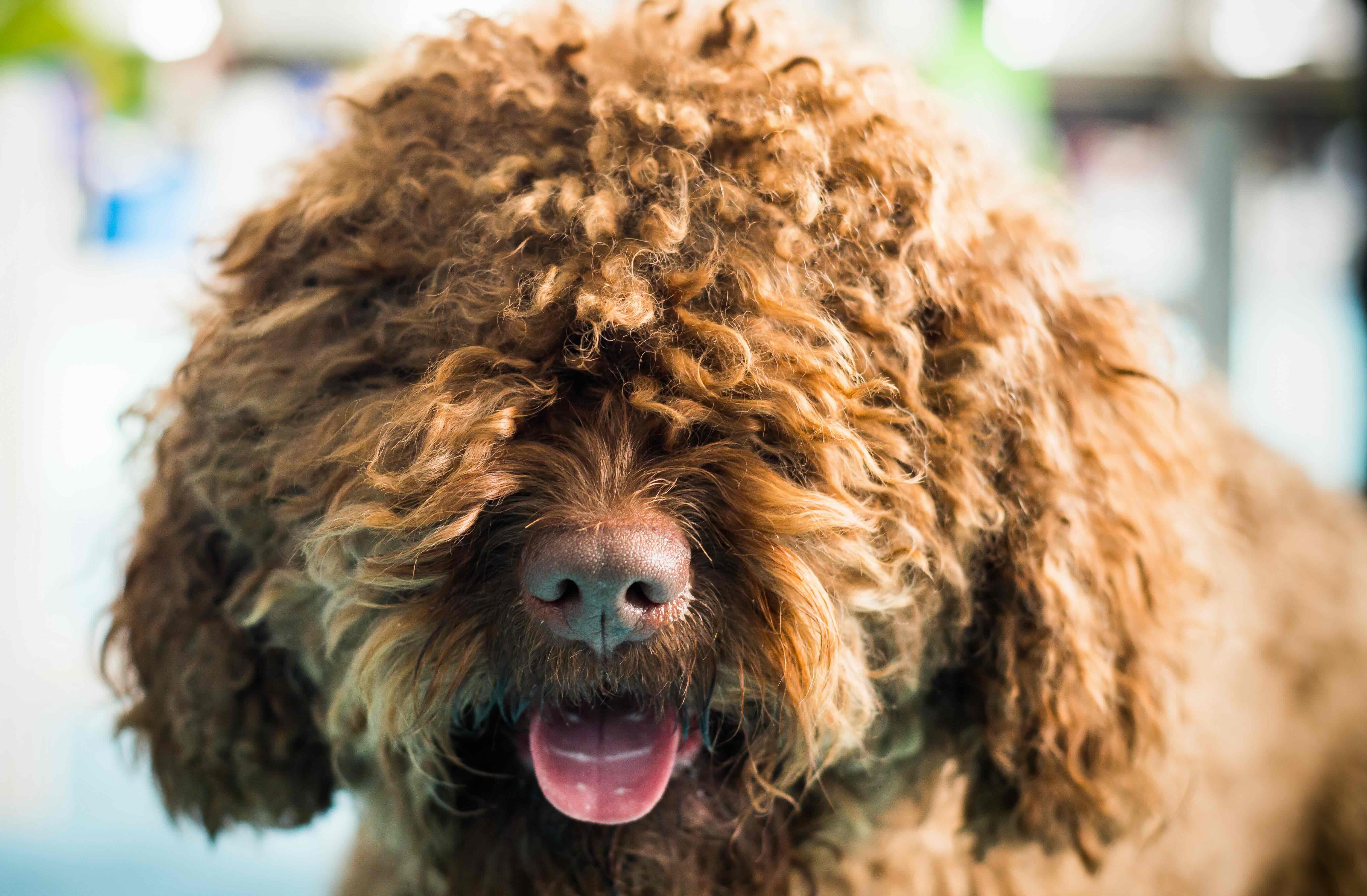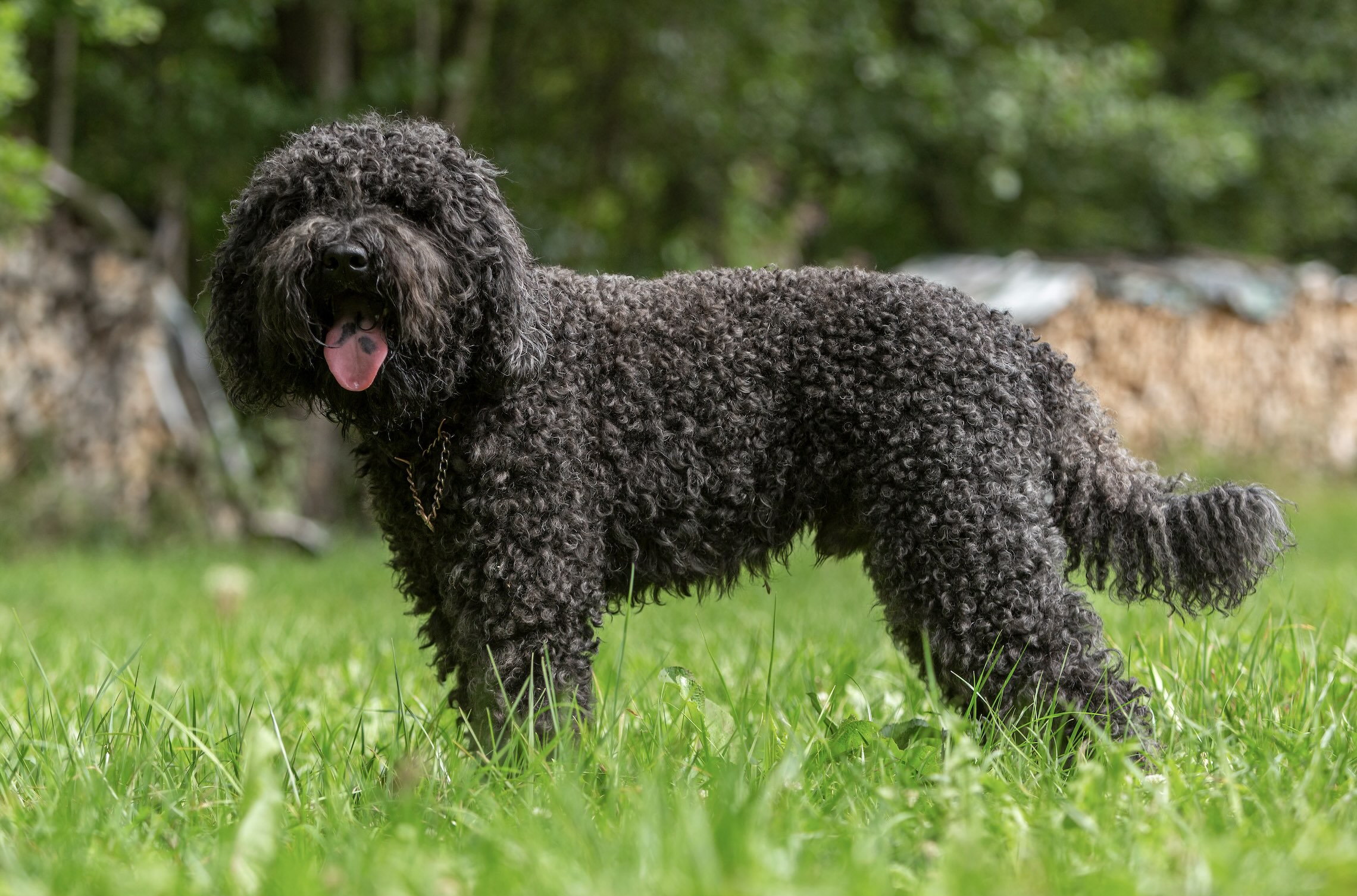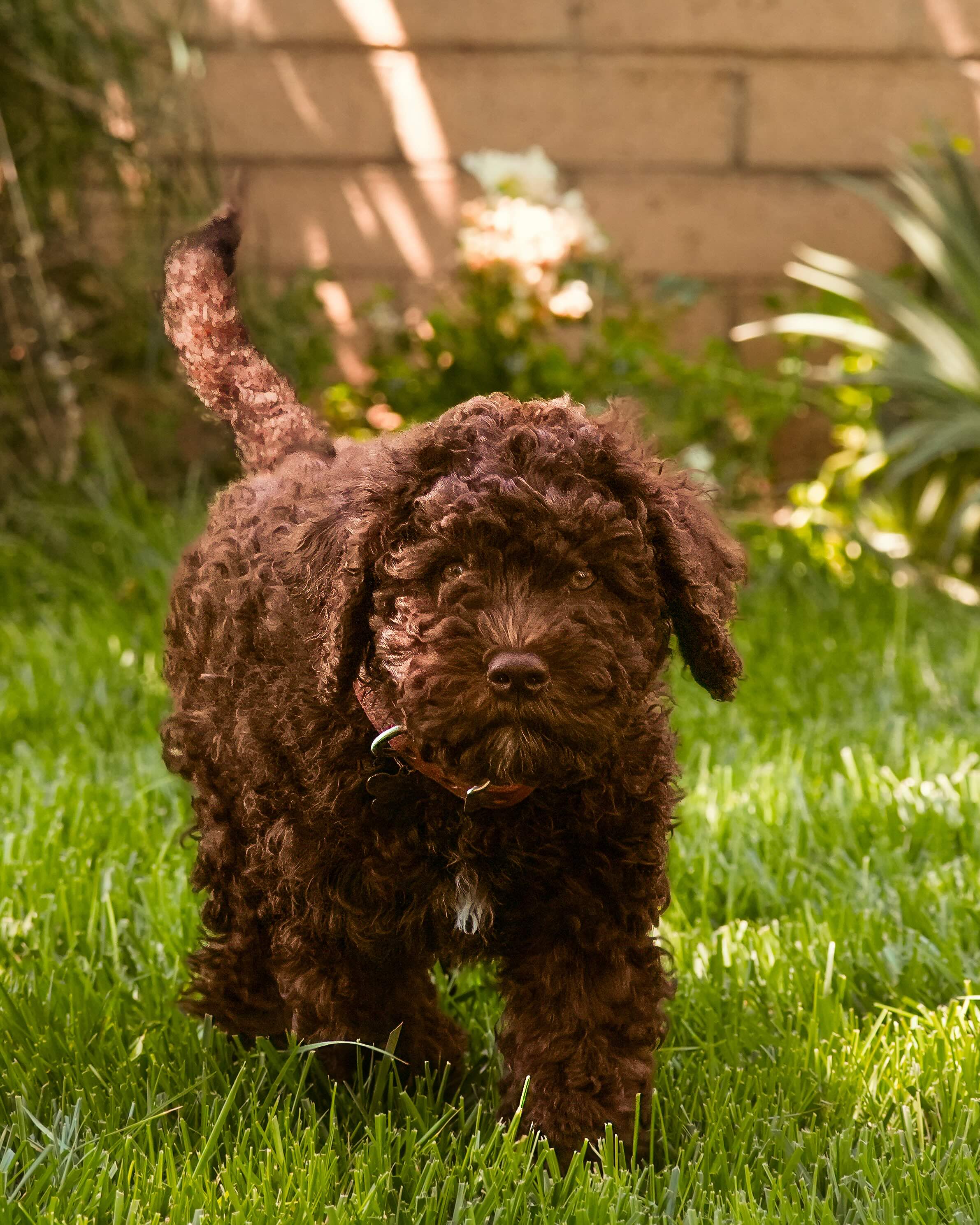Barbet
Cornutus/iStock / Getty Images Plus via Getty Images
The Barbet, a rare and ancient French water dog breed, was originally developed for hunting waterfowl, according to the Barbet Club of America (BCA). Pronounced “bar-bay,” the breed’s name comes from the French word barbe, meaning “beard,” for the dogs’ characteristic facial fur.
The Barbet has a rich cultural influence and has been depicted in various works of art, including paintings and literature, where the breed often symbolizes loyalty and companionship, according to the BCA.
Known for their versatility, Barbet have been employed in numerous roles beyond hunting, such as therapy dogs and as search and rescue canines.
The Barbet is a friendly, medium-sized dog, typically standing 19.5–24.5 inches tall and weighing 35–65 pounds. They have a sturdy build and a distinctive curly, wooly coat that protects them from cold water and harsh weather. The average life expectancy of a Barbet dog is 12–15 years.
Caring for a Barbet
Intelligent, loyal, and highly trainable, Barbet dogs are excellent companions for active families. They’re also known for their playful and gentle nature, which can make them great with children and other pets.
Barbet dogs have a moderate to high energy level, and require daily exercise and mental stimulation through activities like swimming and retrieving. Expect to spend at least an hour exercising your Barbet every day. They excel in canine sports like obedience, agility, and water retrieval.
Along with the need for consistent exercise, the Barbet has a distinctive curly, wooly coat that requires regular grooming to prevent matting, including frequent brushing and occasional professional grooming appointments.
For pet parents willing to invest in a dog’s grooming, exercise, and training needs, the Barbet can make a loyal, adaptable, and loving companion.
Barbet Health Issues

The Barbet is generally a healthy breed but can be predisposed to a few health issues. Regular veterinary care and responsible breeding practices help manage these risks.
Hip Dysplasia
Hip dysplasia is a genetic condition where the hip joint doesn't fit properly into the hip socket, causing pain and arthritis over time. Regular veterinary checkups and keeping your dog at a healthy weight can help manage symptoms.
The condition can be managed medically with joint supplements, pain medication, and physical therapy, but surgery may be necessary in severe cases.
Progressive Retinal Atrophy (PRA)
Progressive retinal atrophy (PRA) is an inherited condition causing the gradual degeneration of the eye’s retina, eventually leading to blindness. There is no cure, but supportive care and adjustments in the dog's environment can help them adapt to vision loss.
Genetic testing can identify carriers, helping reduce the incidence of PRA. Talk to your Barbet breeder about whether their dogs have been screened for PRA.
Ear Infections
Barbet can be prone to ear infections due to their love for water and floppy ears. Regular ear cleaning and keeping their ears dry after being in water can help prevent these infections.
Symptoms of ear infections include scratching, head shaking, and ear discharge. Treatment usually involves ear drops prescribed by a vet.
Allergies
Barbet dogs can develop allergies, which often manifest as itching, redness, and recurring ear infections. Identifying and avoiding allergens, such as specific foods or environmental factors, is crucial.
Special diets, medication, medicated shampoo, and regular grooming may be required to manage your dog’s allergy symptoms.
Epilepsy
Epilepsy in the Barbet dog breed is marked by recurring seizures. While it cannot be cured, it can be controlled through lifelong medication and regular veterinary care.
Pet parents should be aware of the signs of seizures in dogs, which include:
- Limb paddling
- Falling over and becoming stiff
- Urinating or defecating
- Repetitive lip-licking
- Head bobbing
- Twitching
Talk to your vet if you see any of these signs in your Barbet.
What To Feed a Barbet

When choosing dog food for your Barbet, prioritize high-quality proteins, along with fats for energy and muscle maintenance. Ensure the food matches their caloric needs, and talk to your veterinarian for personalized dietary recommendations tailored to your Barbet's health needs.
Your Barbet’s food should meet the nutritional standards set by the Association of American Feed Control Officials (AAFCO) and be formulated for their life stage (puppy, adult, or senior).
How To Feed a Barbet
Adult Barbet dogs do well when fed twice a day on a regular schedule. Barbet puppies may need to eat more frequent meals (three to four every day) before transitioning to two meals when they’re 12–18 months old.
Monitor your dog’s body condition score, and work with your veterinarian for personalized dietary advice.
How Much Should You Feed a Barbet
To determine how much to feed your Barbet, work with your vet and consider your dog’s age, size, activity level, and the guidelines on the dog food packaging. Adjust portions based on their energy needs; active dogs may require more calories.
Nutritional Tips for Barbet
Dogs eating a well-balanced dog food typically won’t need supplementation. That said, certain dog supplements can enhance the overall health of your Barbet by addressing their specific needs.
The following supplements can support your Barbet's well-being:
-
Omega-3 fatty acids (from fish oil or flaxseed oil) can support skin and coat health, which is beneficial for Barbet prone to allergies.
-
Glucosamine and chondroitin aid joint health, which is vital for dogs susceptible to hip dysplasia.
-
Probiotics improve digestion, which can benefit Barbet with food allergies.
-
Antioxidants like vitamins C and E bolster immune function and reduce oxidative stress.
-
Multivitamins can fill nutritional gaps.
Ask your veterinarian for personalized recommendations based on your Barbet's health needs and conditions. Never give your dog supplements without speaking to your vet first.
Behavior and Training Tips for Barbet Dogs
Barbet Personality and Temperament

The Barbet is known for a friendly and affectionate temperament, making the dog breed an excellent companion for many families. They are typically gentle, playful, and intelligent dogs that enjoy being involved in family activities.
Barbet have a moderate energy level, and require regular exercise to stay healthy and happy. They thrive when given tasks or activities that engage their minds, such as obedience training and interactive toys.
Barbet Behavior
Barbet are calm and friendly dogs, and they generally get along well with other pets and children, thanks to their patient and tolerant demeanor.
They are intelligent and curious dogs, exploring their surroundings with occasional barking to alert or express excitement. Keeping your Barbet well-exercised and entertained will reduce the chance of your dog engaging in undesirable behaviors like excessive barking or digging.
Barbet Training
Barbet dogs respond best to positive reinforcement training methods, such as being offered praise and treats for following your cues. Keep training sessions consistent and fun to help them learn.
Barbet puppies need proper socialization to be confident and adaptable as they grow and navigate the world. Talk to your Barbet breeder about how they’ve approached socialization, and ask your vet for age-appropriate activities for your puppy. With these strategies, you can foster a well-behaved and confident companion.
Fun Activities for Barbet
-
Swimming and water retrieving
-
Hunting and retrieving exercises
-
Agility courses
-
Nose work
-
Frisbee or flying disc games
-
Obedience training
Barbet Grooming Guide
Barbet are moderately high-maintenance in terms of grooming, needing regular attention to keep their coat in good condition. This breed doesn’t shed very much and is considered a hypoallergenic dog, so they can be a good fit for some people with allergies.
But as the Barbet breed club states, “The non-shedding hair in no way means no grooming. It means more!”
The Barbet’s coat requires regular grooming to prevent matting and to maintain its health and appearance. This includes regular brushing, occasional bathing, and periodic trimming.
Coat Care
Barbet require consistent coat care to manage their dense, curly fur.
According to the breed club, Barbet dogs should be brushed two to three times a week with a slicker or pin brush to prevent matting, particularly in areas prone to tangling, such as behind the ears and under their legs.
Regular bathing using a gentle, dog-specific shampoo helps keep their coat clean and debris-free. Professional grooming may be beneficial for maintaining overall coat health.
Skin Care
Dry your Barbet thoroughly after bathing them or allowing them to swim. This will help your dog avoid moisture-related skin issues, such as skin infections.
Pay attention to your dog’s skin during regular grooming sessions. Contact your vet if you notice signs of irritation or dryness.
Eye Care
Barbet generally do not have bulgy eyes or significant issues with tear stains. However, regular eye care is important.
Pet parents should routinely inspect their dog’s eyes for redness, irritation, or discharge and seek veterinary attention if needed.
Ear Care
The Barbet’s floppy ears and love for water means they are prone to developing ear infections. This makes regular cleaning with a veterinarian-approved ear cleaner an important part of their care. Making sure their ears are clean and dry is key to preventing infections.
Considerations for Pet Parents
Before adopting a Barbet, consider their need for regular exercise and mental stimulation. They thrive in homes where they can participate in activities like obedience training and retrieving games.
Barbet are social and enjoy interacting with family members, including children and other pets, making them ideal for households that provide companionship and socialization opportunities. They may not thrive in homes where they are left alone for extended periods without stimulation.
Grooming is crucial to manage their dense, curly coat. Brushing is required at least twice a week, and your Barbet will need occasional professional grooming as well.
Understanding and meeting a Barbet dog’s needs ensures a fulfilling environment for this friendly and adaptable breed.
Barbet FAQs
How much does a Barbet dog cost?
The typical Barbet dog price ranges from $2,000 to $4,000 or more. It's essential to thoroughly research Barbet breeders to ensure they follow ethical practices and prioritize the health of their dogs.
You can also find Barbet dogs for adoption at certain breed-specific rescue organizations.
Are Barbet dogs rare?
Yes, Barbet are considered rare. The American Kennel Club (AKC) ranked the Barbet 136th out of 200 breeds on its 2024 list of most popular dogs in the U.S.
Are Barbet dogs cuddly?
Yes, Barbet dogs are known for their cuddly and affectionate nature. They typically enjoy close interaction with their families, and are often described as loving and friendly companions.
Do Barbet bark a lot?
All dogs bark, but Barbet are not known to be excessive barkers. They may bark occasionally to alert their pet parents or express excitement, but overall, they tend to be moderate in their vocalizations compared to some other breeds.
